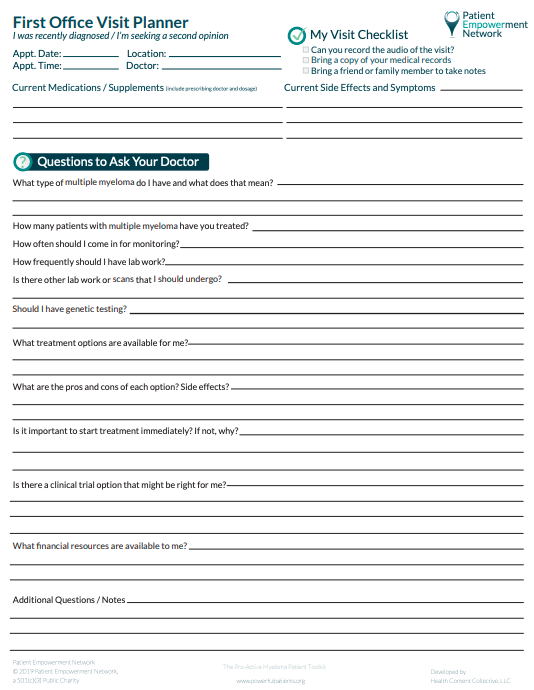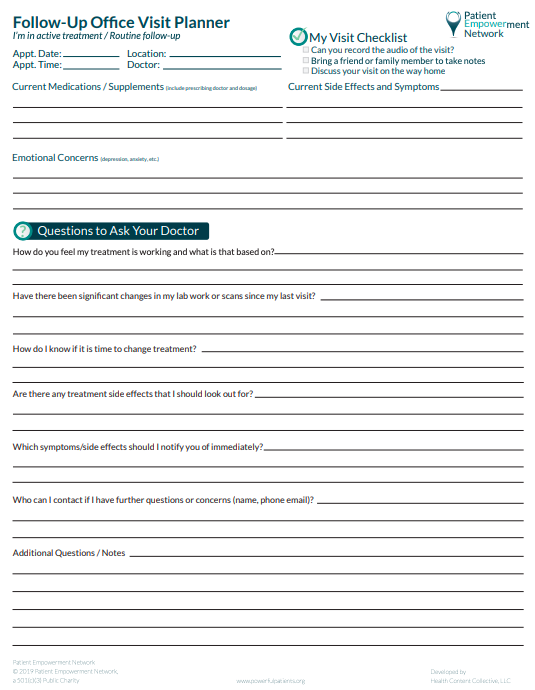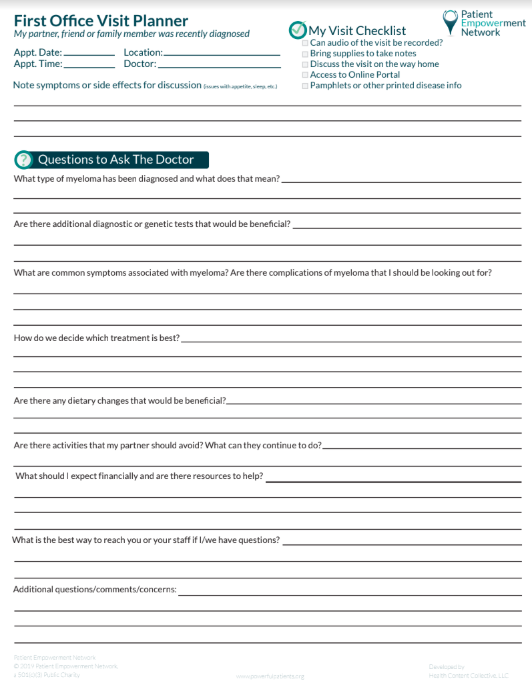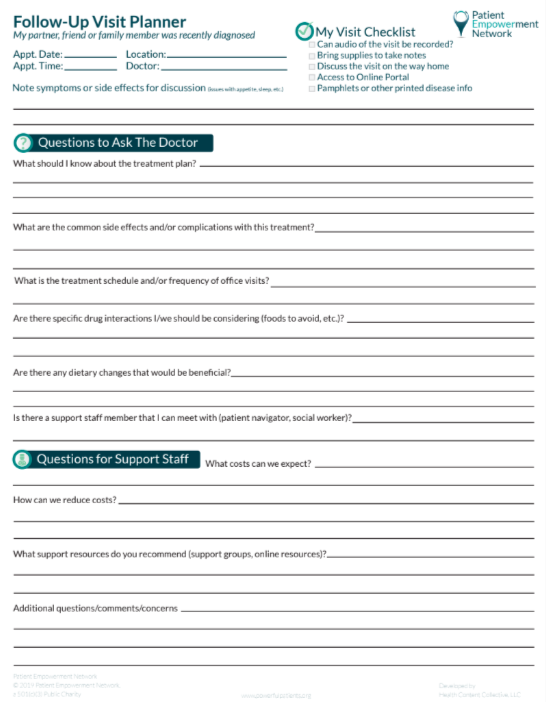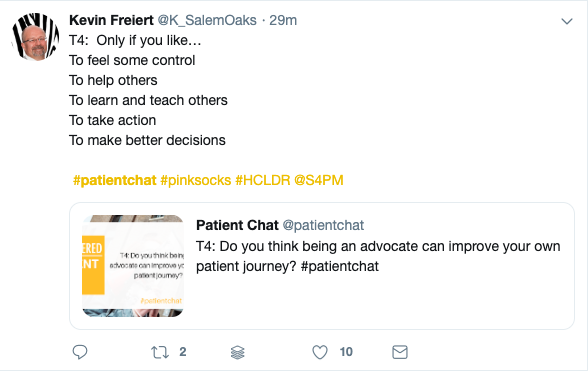The Empowered Lung Cancer Thriver and Expert Chat
The Empowered Lung Cancer Thriver and Expert Chat from Patient Empowerment Network on Vimeo.
Transcript:
Laura Levaas:
Hello, and welcome to this Patient Empowerment Network program, the empowered cancer survivor and expert chats. I’m your host, Laura Levaas, the lung cancer community manager for Patient Power, and a two-year survivor and thriver of lung cancer. This program is produced by Patient Power. We thank Celgene Corporation, Novartis, and Pfizer for their financial contributions to this program. They don’t have editorial control, but we do really appreciate them helping us make this program happen.
So, our guest today is Dr. Ross Camidge, the Director of Thoracic Oncology at the University of Colorado here in Denver. He’s also one of the top doctors in the U.S. for the very type of lung cancer that I have. It’s a rare mutation called ALK positive. And hopefully he can talk about that a little bit more later.
Dr. Ross Camidge:
We can talk about that until the cows come home.
Laura Levaas:
That’s good. Well, I’m excited to be interviewing somebody who is in the same town as me. So, you’re right down the road.
Dr. Ross Camidge:
Yeah, and we’re doing it virtually. Isn’t that crazy?
Laura Levaas:
It is crazy. So, we’re both in Denver, but we’re both online. So, I hope you’re having a good day. And thank you for joining us. So, can you estimate how many lung cancer patients you’ve worked with during your career?
Dr. Ross Camidge:
More than 1,000, I would have thought. So, I tend to see about 30 people a week, of whom about two or three of them are new each week. And then you can do the math. And then I’ve been here…it’ll be 15 years in October. So, someone really clever with a calculator can do that calculation, but it’s several thousand.
Laura Levaas:
That’s a lot.
Dr. Ross Camidge:
Yep.
Laura Levaas:
Is there a case that stands out to you in your career? Maybe somebody who beat the odds of their prognosis, or somebody that had a very interesting or unusual case?
Dr. Ross Camidge:
Well, you know, it’s funny. I mean, there are lots of people who I’ve looked after who’ve inspired me in different ways. But the ones that I keep thinking about the young patients who were diagnosed before we knew about all these molecular sub-types of lung cancer.
And I remember one young guy. He was 21 years old. He was really into skateboarding and art. And his parents were busy getting a divorce at the time. And it was a total disaster to have a diagnosis of lung cancer, and he’s stuck in the middle. And his disease was incredibly aggressive, and he didn’t survive very long. And somewhere in me, it’s like, well, he must have had something. He must have had ALK; he must have had ROS1.
And these things weren’t even described at the time. And part of life is about timing. So, nobody wants to have lung cancer. But it’s a much better time to have lung cancer now than it was last year, and certainly last decade.
Laura Levaas:
Right. So, there is hope for people who are diagnosed now?
Dr. Ross Camidge:
Well, I mean, I think that the best example of that is, people who now have Stage 4 lung cancer, the questions they have to ask are, “Shall I go for promotion in my job? Shall I go on this fun vacation? Am I gonna marry this person?” The same things that we all struggle with before a diagnosis of lung cancer. Because there used to come a time when you got a diagnosis of lung cancer, and the same conversation at least that the doctor was concerned was, “You’re about to drop down dead.” We phrased it differently, but you get the drift.
And now, those are completely separated by an unspecified amount of time, in the same way that we’re born and we die at some point in the future, and we don’t quite know when that’s gonna be. And so, we don’t have the two things – “Hi! Mrs. Jones! You’ve got a bouncing boy and they’re about to drop down dead.” Now, they’re separated by life. And we are gradually increasing the distance between those two events.
Laura Levaas:
I think that’s amazing. And this is a good segue, actually, for me to tell a little bit about my story. I don’t wanna get too far into the weeds. But my story, I think it was unique because I had a threemonth prognosis, basically, by the time they got a hold of me. I’d been misdiagnosed for about a year, which is pretty common, I think, with –
Dr. Ross Camidge:
Yeah.
Laura Levaas:
– lung cancer. You know, allergy symptoms, some migraine symptoms. And mine was actually caught, oddly enough, during a breast cancer screening. Because my mother is a breast cancer survivor, and she was diagnosed very young. So, my doctors have always been really proactive about that. But my original prognosis was three months. And that’s before they knew that I was ALK positive. So –
Dr. Ross Camidge:
So, who told you that you had three months?
Laura Levaas:
It was –
Dr. Ross Camidge:
That’s what drives me crazy, some well-meaning person in the emergency room.
Laura Levaas:
Yes. And I think it’s because when they discovered what I had, I had 50 brain mets and 50 spine mets, and my brain was swelling. And they were telling my family, “We’ve gotta get her into whole-brain radiation right away.”
We found out about two weeks later that I was ALK positive. So, they stopped the radiation, and I went right into taking Alectinib, which is a newer drug. And it was approved by the FDA I think about three months after I started taking it as first line for ALK.
Dr. Ross Camidge:
It’s all about timing.
Laura Levaas:
And then it stopped – yeah. Yeah. So, it’s kind of – I feel a bit like a champion. Because they said, “Well, you have three months.” And that can be a real bummer. And it’s a real shock to friends and family and my boyfriend at the time, who’s no longer. But here I am, 26 months later. And I feel great. And nobody ever thinks that I’m sick. They’re always shocked to find out that I have lung cancer. So –
Dr. Ross Camidge:
I think you’ve done great. And you’re still doing great.
Laura Levaas:
Thank you. And let me explain to our audience how I met you. One of the things that helped me have a positive outlook on being diagnosed with lung cancer is, No. 1, because I have this mutation, there was a targeted therapy available to me. And so, within six months, all of the cancer ground to a halt.
And I was basically able to resume most of my normal activities. I could drive again. I could go out to eat. I could do some normal things. But a friend of mine told me that there was a Facebook group for my specific type of cancer. And it was so valuable, and it helped me sort of like find my people. I refer to them affectionately as mutants because we’re all mutants together. But we share information. And they told me about your second opinion program, which I hope is okay to talk about on –
Dr. Ross Camidge:
Sure.
Laura Levaas:
– this program. But that’s how I found out about you. And you’re now my oncologist. And I’m in a Phase 2 clinical trial for a drug that’s new to me. And I’m very excited about that.
Dr. Ross Camidge:
You haven’t started it yet, have you?
Laura Levaas:
I have. I started it last week.
Dr. Ross Camidge:
Oh, you started last week, didn’t you?
Laura Levaas:
I did. I did. The first couple days, I felt weird. But now, I feel great. So, for those –
Dr. Ross Camidge:
Yeah, that’s fantastic.
Laura Levaas:
– that are watching, just know I do think having a positive attitude will help you through those really tough times when you’re feeling low. Reach out to your sub-group. Reach out to the people who have what you have. Because they’ve been walking that path, and they can help you.
Dr. Ross Camidge:
I mean, I think that one of the things is – I mean, it’s the same like when doctors talk to doctors. You can do the shorthand. You don’t have to explain what you’ve got and what it means. You don’t have to explain to me that you weren’t a smoker. You can just sort of jump in and say, look, this is the stuff that’s happening with me. And they understand.
Laura Levaas:
Absolutely. Absolutely. So, I am going to ask you a couple of quick questions. And then we got a lot of audience questions for you. So, I hope you’re ready.
Dr. Ross Camidge:
Yep. Bring it on.
Laura Levaas:
Lots of really good questions. So, before we transition into those, I wanted to ask whether you have noticed a mindset shift? You mentioned right at the beginning that this is the best time to be diagnosed with lung cancer because there are options. But are you noticing a mind shift in your patients?
Dr. Ross Camidge:
Yeah, I mean, I think there is. I mean, I think lung cancer has gone from being – or let me rephrase that. Certain sub-groups of lung cancer has gone from being this kind of embarrassing thing, that you were sort of hidden in a closet, and nobody knew a lung cancer survivor because they didn’t exist – to now, I can show a room full of people and you can’t pick out who’s the lung cancer patient and who’s their significant other in the picture because everybody looks the same. And that, to me, is huge success.
So, I mean, one of the things we did last year – and I may have shown you the picture that we have up in the clinic – is we actually had a survivors’ celebration.
Laura Levaas:
Awesome.
Dr. Ross Camidge:
And to get your invite, you had to be at least five years out from your diagnosis. And we invited 400 people. Now, to be honest, we messed up the timing, and we sent the invites out about two weeks late. But we still had about 100 people turn up –
Laura Levaas:
That’s great.
Dr. Ross Camidge:
– which was pretty awesome. And we took a big picture. And it’s framed and sitting up in the clinic, for the simple reason that when you’re first diagnosed, you know these people exist, but you don’t believe they’re real. And I wanted to be able to come outside and say, “See that guy there? Well, he’s 10 years out. And look, he still looks fine, and he’s leading a normal life.”
So, I don’t mean everybody’s gonna do that. But it’s gone from being this fantasy – I might win the lottery – to, well, I might graduate from high school. I mean, it becomes a much more realizable dream.
Laura Levaas:
Right. Well, what questions do you think patients should be asking when they’re first diagnosed? They go to the doctor. They’re like, “You have lung cancer.” What should a patient ask?
Dr. Ross Camidge:
Well, some of the basics are, what’s the stage of the cancer? How far has it spread around the body? So, usually, at least in the USA, people are getting a PET scan and an MRI of their brain.That’s the kind of standard bread and butter. I mean, 10 year ago, probably the most common thing I would encounter in the second opinion is somebody who wouldn’t have scanned the brain. They were waiting until someone had symptoms before they scanned it, which was like, well, you’ve lost a few neurons by then.
Now, probably the big thing is, have they done molecular testing? And I think the education has been, that’s not a uniform box. If you find something, that’s great. But if somebody says, “Well, you don’t have a mutation,” the next question is, “Well, what have you looked for?” Because if you haven’t looked for A, B, and C, you don’t know that that’s not there. So, the things that we test for have become more expansive.
And then the last one – and it’s hard not to say this without sounding like a complete jerk, but I’m going to do it anyway – is that the disease has become super complex and super specialized. And you don’t have to have all of your treatment with a thoracic specialist, but you should have a relatively early appointment with a thoracic specialist to just check that you’re on the right path.
Laura Levaas:
Good. That’s –
Dr. Ross Camidge:
Those are the three things.
Laura Levaas:
Okay. Those are really, really good things to ask. I wanted to ask also how long you’ve been involved in lung cancer clinical trials in the development of new medicines?
Dr. Ross Camidge:
Well, I’ve been here, as I said, nearly 15 years. I trained before that amongst other places in Edinburg, in Scotland, which is where I did most of my training. And that’s where I first encountered lung cancer patients. And it was actually probably the very first – so, you were taken round to different centers in your training. And I landed in lung cancer. And I really liked the patients. And I kind of felt that they were … they were very undemanding. Often, many of them had smoked, and they were kind of feeling a little embarrassed. And so, they made you want to step towards them because they were kind of stepping away from you. And I also felt that it was kind of poised for a breakthrough. So, that was kind of how I got involved.
And then since I’ve been here, when I first arrived in Colorado, it was pretty well known for lung cancer. But it had not a huge clinical program. I think when I arrived, they put nine patients a year on clinical trials. And within a few years, we were putting more than 100 on. So, I really helped to build that. And then with my colleagues here, we’ve been able to build the program.
Laura Levaas:
What’s the best advice you can give someone who is newly diagnosed with cancer?
Dr. Ross Camidge:
Well, the first thing is, for those of you who’ve seen The Hitchhiker’s Guide to the Galaxy, the first thing is, don’t panic.
Laura Levaas:
That’s good advice. That’s good advice.
Dr. Ross Camidge:
The thing is, what you do is, you get diagnosed. And there’s a period of time where the room – you just can’t hear anything, and you feel distant from it. And what you’ve gotta do is, you – absolutely, you can wallow in self-pity for a period of time. And then you have to get up and move on. And that’s when you say, okay, this is a problem like anything else in life. And I will figure out the best of all possible solutions.
Laura Levaas:
Absolutely. Conversely, Terry wanted to know, what is the biggest mistake patients make in decisionmaking about treatment?
Dr. Ross Camidge:
Well, listening to people who say you only have three months to live.
Laura Levaas:
Yeah. That’s not good.
Dr. Ross Camidge:
Yeah. I don’t know what – I think perhaps believing that everything you see about cancer on the TV – which is everyone who’s bald and throwing up – must automatically apply to you. Or that that person down the street who died from a brain tumor automatically applies to you. I mean, so, cancer isn’t cancer. There are different diseases. And until you can find out, like you said, your peer group, you don’t know what the truth will be for you. And then you’re still gonna make your own rules up anyway.
Laura Levaas:
That’s true. That’s true. And I was thinking the other day, my needs when I was first diagnosed are very different than what they are now a few years later. Because in the beginning, I didn’t have coping skills. And I just didn’t know what to do. But you do develop them over time. And I remember a woman telling me, “Oh, you’ll figure it out.” And that made me really mad. But I see the wisdom –
Dr. Ross Camidge:
Yeah.
Laura Levaas:
Yeah. I see the wisdom in that now because you do figure it out over time.
Dr. Ross Camidge:
But how did you figure it out? How did you develop those coping skills? … Am I allowed to ask you questions?
Laura Levaas:
Oh, absolutely! Yeah, I think it was helpful, oddly enough, that I wasn’t allowed to drive and that I was in such a bad state. Because it allowed me to sort of withdraw from society for a while, withdraw from my work, withdraw from relationship drama. Because I ultimately ended up breaking up with my partner because he wasn’t capable of handling what I was going through, and he wasn’t supportive. So, all of the things that were familiar to me, like my job, my apartment, I retreated from all of that. And at the time, it sucked. But now, I’m like, that allowed me to have a perspective that was removed from everything. And I just –
Dr. Ross Camidge:
How old was your son at the time when you were diagnosed?
Laura Levaas:
Four.
Dr. Ross Camidge:
So, I mean, there’s an element of where you can withdraw from society, but you’ve got a 4-year-old.
Laura Levaas:
That’s right.
Dr. Ross Camidge:
So, how do you deal with that?
Laura Levaas:
Yeah. Well, I ended up moving in with my sister. Because at that time, I couldn’t drive, and I couldn’t take care of myself. So, I did rely really heavily on her. And their daughter is the same age as my son. So, they were going to school together. I relied very heavily on them, and I’m so thankful for that because that allowed me to just rest and heal. Because in the beginning – not to get too far in the weeds – but I couldn’t watch TV. I couldn’t be on my phone. I couldn’t be on the computer. Just no attention span whatsoever because of whole brain, I think. So, retreating from everything actually was good for me. And I’m also kind of a loner. So, I liked it, being alone too, oddly enough.
Good question.
I have another question from Christine C. She says, how long do you think it will take until lung cancer will be a chronically managed disease?
Dr. Ross Camidge:
Well, I think for some people, it already is. So, I now have 10-year Stage 4 survivors who are still alive and still thriving, to use your word. So, for those people, it’s a reality. And I don’t know – as I said, people will make their own rules – I don’t know how long they will go. I mean, I honestly do not know how long I can control their disease. You just have to stay alive and in the game and hope that breakthroughs will happen.
Now, then the challenge is, okay, “Well, what about me? I don’t have ALK. I don’t have – whatever.” And you go, okay, well, so, everyone – we have to try and replicate the success of the ALK positive population with all of the other sub-types of lung cancer or the ones that don’t even have a label yet. And so, there’s plenty of work to do.
Laura Levaas:
Definitely. Leslie wants to know, what do you see in the near future for treatment of lung cancer? And she lists a couple of things like a fourth generation TKI, immunotherapy – a couple of things that I don’t even know what they are, SHP2, Protex, anything else?
Dr. Ross Camidge:
Yeah. I don’t know what Protex is, but I know what SHP2 is. So, first of all, so, the concept of the fourth generation TKI, I mean, I assume that’s because we have a third generation TKI and therefore, the next one must be called the fourth generation. So, I don’t know that the generations of TKI is going to be the immediate solution.
If I had to say what I think the future is gonna hold, there’s a couple of things. So, one is I think we can – and we’ll use ALK as an example. But really, ALK is this model system that everybody else with lung cancer might like to replicate. So, we’re really good at developing drugs that are great at suppressing one particular pathway that is driving some people’s cancer.
But the cancer still grows eventually. Usually now, with some of the drugs – like the one you’re on and the third-generation drug – is that they’re not growing because they’re turning back on the same pathway. What they’re doing is, they’re growing through some other pathway coming up. So, finding these other pathways, these so-called second drivers, is going to lead to rational combinations of drugs. That’s one way.
The other thing which is kind of the elephant in the room is, well we have these drugs. You have these fantastic responses on the scans. But if you stop the drug, the cancer starts to grow. And if you go back on the drug a week later, it’ll shrink down. So, you clearly haven’t killed all of the cells which are even sensitive to that drug. So, until we can address why we can’t get 100 percent cell kill – that’s a technical term – we’re never gonna deal with the elephant in the room, which is, why can’t we actually cure people?
And that’s a very different situation from, why does the cancer grow three years later? The question is, why, when you walk through the door and you have a great response on the scan, if you had a magic microscope, why is there still one in 1,000 cells left? And that to me is actually the horizon we need to look for.
Laura Levaas:
Okay. Okay. That’s a great answer. A few more questions. Will R. wants to know about a lung cancer vaccine.
Dr. Ross Camidge:
Well, so, you could view that in a couple ways. So, if you think about how we use vaccines, we use them when we don’t have a disease to prevent us from getting that disease. We don’t really use a vaccine when we’ve already got the disease. So, if you’ve got chicken pox, I don’t vaccinate you for chicken pox. I treat the chicken pox. And so, lots of people are trying to develop vaccines, but they’re giving them in the wrong way. They’re giving them to somebody with an established lung cancer, and then they’re surprised that it doesn’t work. But that’s not what vaccines do.
The question is, could we find a way of saying, well, these are the people who are at highest risk for lung cancer, and give them something before they have lung cancer to reduce their risk? And the answer is, maybe. But if you can imagine, that’s a really difficult study to do. It would take years and years and years.
I’ve just come back from something called the World Conference on Lung Cancer, which was in Barcelona – tough life – but the biggest breakthrough there wasn’t about treatment. It was about a study that was actually done in Scotland about screening people. So, we’re pretty familiar with, if you smoke this much, you meet a certain criteria, and you go get a CT scan. But that’s no good if you’re not a smoker. You don’t meet those criteria.
So, they still have to look at a blood test. And they can show that that particular blood test, it wasn’t definitive. It wasn’t, you’re gonna get cancer or not. But it bumped up your risk if you are positive on the blood test to then make that screening even more effective.
Laura Levaas:
That’s awesome.
Dr. Ross Camidge:
And they had some evidence – loose evidence – that it might even work in never smokers. And I think that’s what will come in the future too. And then what if you identify this high-risk group? I’m getting all excited now – all that higher-risk group? Maybe then say, okay, well, why are they at higher risk? Is that the group we give a vaccine to?
Laura Levaas:
Right. And then how would you identify a non-smoker, high-risk group? Can you?
Dr. Ross Camidge:
Yeah, well, so, it’s a work in progress. So, one of the things that they’re starting to do is find some of the mutations which are driving people’s cancer in the blood. Okay? So, the problem is that the sensitivity of the test isn’t very good. So, you can find it when somebody has lots of cancer in their body. But to get the screening, you want to find it when there’s one little ditzel in your lung. So, you have to really turn up the sensitivity.
And I think that’s where the field is kinda going. So, they would know that if they found ALK in your blood, if they made a super sensitive test, that that would be wrong. Shouldn’t be there. And therefore, they would say, you should go get a CT scan. And so, the sensible thing would be, develop a cocktail of tests for every one of the things that drive lung cancer and say, if we find it, that’s bad news. Go get a CT scan.
Laura Levaas:
I like that. A cocktail of tests. Good. Well, hopefully, that will be soon. Two more questions. This is a really great question, actually, from Gail O. Is there a resource for local oncologists to reach out to for information and collaboration about lung cancer? Because as I’m sure you know, some of these smaller centers, maybe those physicians aren’t seeing lung cancer patients. So, they – I don’t wanna say they don’t know what to do, but maybe a patient is not getting the appropriate treatment protocol.
Dr. Ross Camidge:
I mean, that’s a really good question. So, it depends on where you are in the world. So, there are guidelines that NCCN, National Comprehensive Cancer Network – which is a common guideline used in the USA – is updated every few months. And that’s a common thing that a private practitioner could look at. And yet, it’s astonishing how many people sort of still don’t follow that. That’s a guideline. And the trouble with guidelines is, they don’t describe every possible scenario. In terms of how do you –? This may come as a huge surprise to you, but doctors have egos.
Laura Levaas:
No!
Dr. Ross Camidge:
No! So, how do you convince a person who may be a very good general oncologist that they don’t know everything? And that’s really hard. So, it’s not that we don’t necessarily have the resource. But we have to have people feel comfortable, if you like, asking for help. And I think that may be the biggest challenge.
I mean, I’ll give you an example. So, here we are in Colorado. There are probably several hundred medical oncologists in the state, of whom a handful ever send us patients for clinical trials. And you go, well, they must all see lung cancer. Lung cancer’s common. So, why do only some of them send people for clinical trials? Either they’re sending them somewhere else – and that’s okay – or they’re just not asking for help. And that is a huge tragedy if that’s happening.
Laura Levaas:
Yeah. So, is there a resource for local oncologists, like –?
Dr. Ross Camidge:
Do you want me to actually answer the question?
Laura Levaas:
If it’s possible. It’s a big question.
Dr. Ross Camidge:
No. I mean, not in a – I mean, there are lots of separate resources. So, all oncologists are subject to CME, continuing medical education. There are videos they can watch. There are updates of all these conferences. But they have to want to do it. Nobody is getting down and forcing them to do it.
Laura Levaas:
Right. And I think that’s where an empowered patient comes in. An empowered patient will seek out the care that they’re looking for.
Dr. Ross Camidge:
Yeah. I mean, I do lots of second opinions. And for many of my patients, they’re around the world and around the country. And sometimes, their oncologist I form a very close relationship with because we both feel like we’re looking after the same person. And you almost feel like you’re kind of a co-parent. And that’s great because they don’t feel threatened by me, and I don’t feel threatened by them, and we can work together. “Well, this has happened. This is what the scan shows. What do you think? And I’ll do this.” And others don’t. But that’s how it can work well.
Laura Levaas:
Okay. Last question. This person’s name is Parentin B. I’ve never heard that name before. It’s very interesting. Are there recommendations about what patients can do themselves, like supplements, diet, exercise, etc., that could be helpful? And I know when I was first diagnosed, that was one of my first questions. Because my physician said, “Well, eat healthy.” And I was like, “Well, what does that mean?”
Dr. Ross Camidge:
What does that mean? Yeah.
Laura Levaas:
So, I think there’s a glut of, should we do Keto? Should we do Paleo? Should we go vegan? Vegetarian?
Dr. Ross Camidge:
I think one of the things is, what this is actually telling us is that when we’re diagnosed, we want to be part of the solution ourselves. We don’t want to be passive and have people do things to us. And I think the physicians who go, “Well, no. Nah,” I mean, they’re missing out on that need to take some aspect of control of our lives.
And so, some of it, you can channel that energy into becoming empowered and educating yourself about it. Not to the point that you’re obsessed about it, but I mean so that you’re, again – occasionally, I get patients who come in, and you go, “So, what treatment are you on?” And they go, “I don’t know.” And you go, “Well, you’re hardly taking control if you wanna change your diet, yet you can’t be bothered to learn the name of your chemotherapy. That’s not empowerment.”
I think diet is something we can all control in our lives. It can also make you – a diagnosis of cancer makes you vulnerable to anyone who wants to sell you any kind of quack theory. I think most people, at least our cancer dietitians here, would say, you bump up the fresh fruit and vegetables. You don’t have to become a juicer. But fresh fruit and vegetables generally make you feel better. They keep your bowels moving more, which sometimes, some of the treatments can interfere with that. You don’t have to feel guilty if you have a candy bar. But if you minimize the amount of highly processed food you have and the amount of sweets, that’s fine. It’s like anything else. You can have cheat dates. Don’t feel bad about it.
But all of that is kind of subjective. There’s people who are gonna tell you, you have to have cottage cheese and flax seed oil or the Gerson diet and have coffee enemas. I prefer my coffee this way, but –
Laura Levaas:
Me too.
Dr. Ross Camidge:
And there are always testimonials about these things, but there’s very little hard evidence that it actually makes a difference. The one exception is exercise. Actually, there’s quite a lot of data that being a healthy weight – so, not overweight, and just being active. It doesn’t mean you have to sign up for a triathlon, but just going for a walk every day or doing something actually makes people feel better, makes them cope with the treatment better. And there’s even some data that actually survival is improved. So, that’s definitely something that people can do.
Laura Levaas:
Well, those are all really good things. And I appreciate these questions. Many of them came from the ALK positive Facebook group that really helped me cope through some of my tough times. And there are some really smart folks in there, way smarter than me. Probably not as smart as you. But they –
Dr. Ross Camidge:
No! Way smarter than me! They’re all like nuclear physicists and things.
Laura Levaas:
I’m really amazed at the amount of specialized information that I’ve been able to find in these support groups. So, kind of winding up. Thank you, Dr. Camidge, for joining us today for – it’s a new program, actually, from the Patient Empowerment Network, but it’s produced by Patient Power. And again, we want to thank Celgene Corporation, Novartis, and Pfizer for their support, even though they don’t have editorial control. We’re kinda driving the bus. And we’re really grateful that you could join us today and answer all of these pressing questions.
Dr. Ross Camidge:
My pleasure.
Laura Levaas:
Thanks. We’ll catch you next time. And everybody, thanks for watching. Please remember the opinions expressed on Patient Power are not necessarily the views of our sponsors, contributors, partners or Patient Power. Our discussions are not a substitute for seeking medical advice or care from your own doctor. That’s how you’ll get care that’s most appropriate for you.

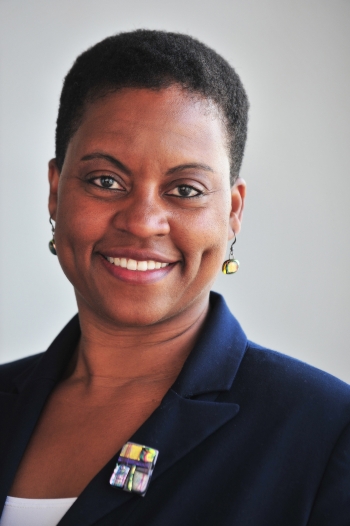 Dr. Lisa Fitzpatrick is an infectious diseases physician, CDC-trained medical epidemiologist and founder of
Dr. Lisa Fitzpatrick is an infectious diseases physician, CDC-trained medical epidemiologist and founder of 


